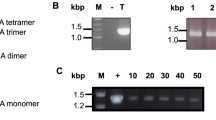Abstract
Influenza is a highly contagious disease and one of the most wide spreaded infection in the world. Influenza type A strains are of very great epidemiological significance. A high degree of genetic variability leads to constant modification in the antigenic structure of influenza virus. Therefore, current influenza vaccines require periodic updating of the composition of the strains. At present, it is important to develop a universal vaccine that could protect against different strains of influenza A virus and it is can be based on the conserved antigens of the virus. Recombinant adenoviral vectors expressing genes of conserved viral antigens may be used for a promising candidate vaccine against influenza A. Using a homologous recombination method, in this study we have developed a recombinant adenoviral serotype 5 vector that expresses the genes of the M2 ion channel and nucleoprotein (NP) of influenza A virus. The genes of the consensus sequences of the M2 protein and NP of human influenza A virus were inserted into the structure of the viral genome. The expression of the M2 and NP antigens using the recombinant adenovirus vector in a permissive line of eukaryotic cells was detected by Western blot assay. The high immunogenicity of the recombinant adenovirus vector obtained was demonstrated by intranasal immunization of laboratory mice.
Similar content being viewed by others
References
Holsinger, L. and Lamb, R., Influenza virus M2 integral membrane protein is a homotetramer stabilized by formation of disulfide bonds, Virology, 1991, vol. 183, pp. 32–43.
Holsinger, L., Nichani, D., Pinto, L., and Lamb, R., Influenza A virus M2 ion channel protein: a structurefunction analysis, J. Virol., 1994, vol. 68, pp. 1551–1563.
Takeda, M., Pekosz, A., Shuck, K., Pinto, L., and Lamb, R., Influenza A virus M2 ion channel activity is essential for efficient replication in tissue culture, J. Virol., 2002, vol. 76, pp. 1391–1399.
Treanor, J., Tierney, E., Zebedee, S., Lamb, R., and Murphy, B., Passively transferred monoclonal antibody to the M2 protein inhibits influenza A virus replication in mice, J. Virol., 1990, vol. 64, pp. 1375–1377.
Ito, T., Gorman, O., Kawaoka, Y., Bean, W., and Webster, R., Evolutionary analysis of the influenza A virus M gene with comparison of the M1 and M2 proteins, J. Virol., 1991, vol. 65, pp. 5491–5498.
Schotsaert, M., De Filette, M., Fiers, W., and Saelens, X., Universal M2 ectodomain-based influenza A vaccines: preclinical and clinical developments, Expert Rev. Vaccines, 2009, vol. 8, pp. 499–508.
Scholtissek, C., Ludwig, S., and Fitch, W.M., Analysis of influenza A virus nucleoproteins for the assessment of molecular genetic mechanisms leading to new phylogenetic virus lineages, Arch. Virol., 1993, vol. 13, nos. 3–4, pp. 237–250.
Shu, L.L., Bean, W.J., and Webster, R.G., Analysis of the evolution and variation of the human influenza A virus nucleoprotein gene from 1933 to 1990, J. Virol., 1993, vol. 67, no. 5, pp. 2723–2729.
Antrobus, R.D., Berthoud, T.K., Mullarkey, C.E., Hoschler, K., Coughlan, L., Zambon, M., et al., Coadministration of seasonal influenza vaccine and MVA-NP+M1 simultaneously achieves potent humoral and cell-mediated responses, Mol. Ther., 2013. doi 10.1038/mt.2013.162
Sediva, E.S., Shmarov, M.M., Tutykhina, I.L., Barykov, A., Verkhovskaya, L.V., Logunov, L.Yu., et al., Protective properties of candidate gene engineering vaccines against avian influenza virus, developed on the basis of recombinant adenoviral vectors, Zh. Microbiol., 2010, vol. 3, pp. 44–48.
Shmarov, M.M., Sedova, E.S., Verkhovskaya, L.V., Rudneva, I.A., Bogacheva, E.A., Barykova, Yu.A., et al., Induction of a protective heterosubtypic immune response against the influenza virus by using recombinant adenoviral vectors expressing hemagglutinin of the influenza H5 virus, Acta Nat., 2010, vol. 2, no. 1, pp. 119–126.
Gannage, M., Dormann, D., Albrecht, R., Dengjel, J., Torossi, T., Ramer, P., et al., Matrix protein 2 of influenza A virus blocks autophagosome fusion with lysosomes, Cell Host. Microb., 2009, vol. 6, no. 4, pp. 367–380.
Ilyinskii, P., Gabai, V., Sunyaev, S., Thoidis, G., and Shneider, A., Toxicity of influenza A virus matrix protein 2 for mammalian cells is associated with its intrinsic proton-channeling activity, Cell Cycle, 2007, vol. 6, no. 16, pp. 2043–2047.
Tripathi, C., Batra, J., Cao, W., Sharma, K., Patel, J., Ranjan, P., et al., Influenza A virus nucleoprotein induces apoptosis in human airway epithelial cells: implications of a novel interaction between nucleoprotein and host protein Clusterin, Cell Death Dis., 2013, vol. 4, pp. 562–574.
Butel, J., Melnick, J., and Rapp, F., Detection of biologically active adenoviruions unable to plaque in human cells, J. Bacteriol., 1966, vol. 92, no. 2, pp. 433–438.
Donnelly, M., Luke, G., Mehrotra, A., Li, X., Hughes, L., Gani, D., et al., Analysis of the aphthovirus 2A/2B polyprotein “cleavage” mechanism indicates not a proteolytic reaction, but a novel translational effect: a putative ribosomal “skip,” J. Gen. Virol., 2001, vol. 82, pp. 1013–1025.
Szymczak, A., Workman, C., Wang, Y., Vignalil, K., Diliogloul, S., Vanin, E., et al., Correction of multigene deficiency in vivo using a single “self-cleaving” 2A peptide-based retroviral vector, Nat. Biotechnol., 2004, vol. 22, no. 5, pp. 589–594.
Author information
Authors and Affiliations
Corresponding author
Additional information
Original Russian Text © I.B. Esmagambetov, E.S. Sedova, D.N. Shcherbinin, A.A. Lysenko, M.N. Garas, M.M. Shmarov, D.Yu. Logunov, 2014, published in Molekulyarnaya Genetika, Mikrobiologiya i Virusologiya, 2014, No. 2, pp. 22–28.
About this article
Cite this article
Esmagambetov, I.B., Sedova, E.S., Shcherbinin, D.N. et al. Construction of recombinant adenoviral vector expressing genes of the conservative proteins M2 “ion channel” and nucleoprotein of influenza A virus. Mol. Genet. Microbiol. Virol. 29, 69–76 (2014). https://doi.org/10.3103/S0891416814020050
Received:
Published:
Issue Date:
DOI: https://doi.org/10.3103/S0891416814020050




